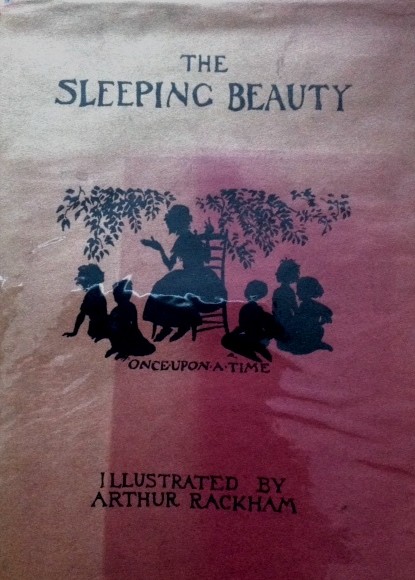Inspiring Young Readers
 posted on 20 Jan 2021
posted on 20 Jan 2021
The Sleeping Beauty illustrated by Arthur Rackham
The first thing that might strike you about this fine 1920 first edition is the very ordinary pinkish red dust jacket with a silhouette illustration of a storyteller and a small audience of children on the front. Let’s be honest: it’s rather drab. But actually, it was meant to be because this was an age when the dust jacket had no value and was designed to be discarded once the book had been purchased and all the effort went into the board covers that were underneath. And so it is here. Take off the dust jacket and a typically beautiful – albeit restrained – illustration emerges that does real justice to the name of Arthur Rackham.
I’m sure that if you’re interested enough to be reading this article I don’t need to go on too much about the skills of Rackham as a children’s book illustrator. What you might be less familiar with is the style he adopts for this book. The constant motif of the book is the black silhouette and this is used throughout the book in small, medium and double spread illustrations generously scattered throughout. All that would be perfectly acceptable but what turns this edition into a real collectible is Rackham’s inclusion of a handful of glossy double page spreads where the basic silhouette is supplemented by colour – and what unusual colour it is. Pink and olive green is a limited palette but the way it is used here is masterful and lifts the drawings in a way that suggests any other colours would be entirely superfluous.
The book was published by William Heinemann and I can’t quite escape the feeling that the publisher was just a little nervous about Rackham’s spare illustrative style – after all he was an artist famed for his rather intricate and detailed drawings and lavish use of colour. This niggling doubt probably accounts for the insertion of a more ‘typical’ or ‘traditional’ tipped-in Rackham illustration entitled ‘Briar Rose’ and heavily framed by foliage which looks slightly out of place and something of an afterthought.
The existence of the rare book jacket makes this a considerably more collectable - and valuable – copy than the ones without. It’s hard to defend the stupidity of a market that invests such huge value in paper covers designed to be thrown away but that is how it works and in this case it makes a book that would have been worth maybe £80 into one which sells for £300. I need to say here that you don’t need the dust jacket to enjoy everything that this books has to give – the contents are what is important and they are truly delightful and a work of art that will entrance.
Terry Potter
January 2021



